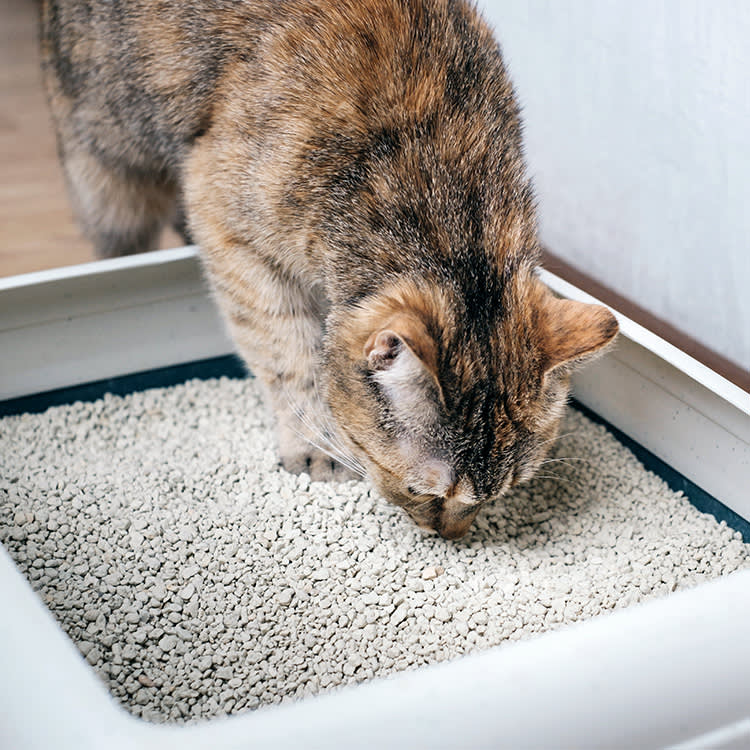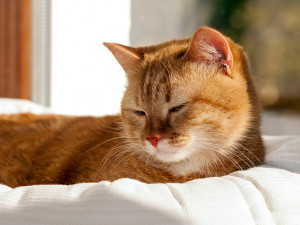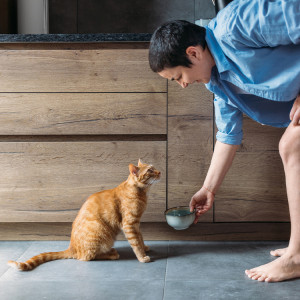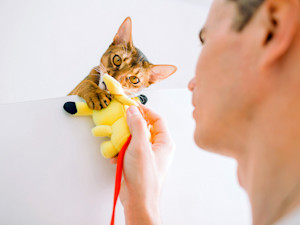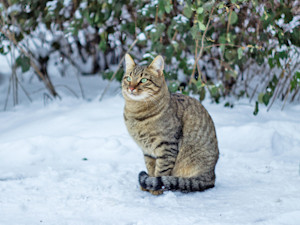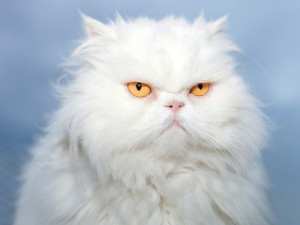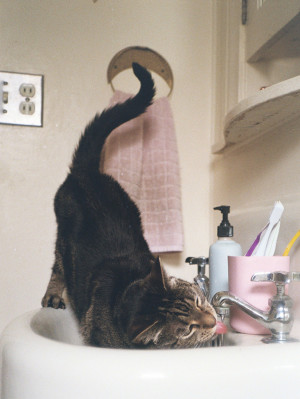Winter Woes: How to Stop Feline Cystitis This Season
Why winter brings a spike in kitty cystitis cases
In this article:
What is feline idiopathic cystitis (FIC)? Symptoms of FIC Why FIC is more common in winter Stress and FIC How to prevent FIC When to see a vet for FIC
As the festive countdown begins and families immerse themselves in the excitement of Christmas, one four-legged family member might not share the same enthusiasm: your cat. Winter months, particularly the holiday season, often see a rise in cases of feline cystitis, specifically feline idiopathic cystitis (FIC).
Often overlooked during the busy period, the condition can escalate quickly if unnoticed, leading to cats becoming acutely ill and needing emergency veterinary visits as they struggle with their symptoms. So, why is feline cystitis more common during this time, and what steps can you take to manage your cat's health during winter months?
What is feline idiopathic cystitis?
FIC (feline idiopathic cystitis)opens in new tab is a very painful condition causing inflammation of the bladder in cats. Cystitis is a common urinary tract infection (UTI) that causes inflammation, usually from an infection. However, the term ‘idiopathic’ means no specific cause has been identified.
There can be multiple factors that can be seen to contribute towards the cause of the disease including; obesity, leading a sedentary lifestyle, indoor-only cats without enough enrichment and unable to express natural behaviours, multi-cat households with inter-cat conflict, genetics and early life experiences.
Recognising the symptoms of FIC
Physical signs, which can be physical or behavioural, will include one of more of the following.
Physical:
Blood in the urine.
Difficulty in passing urine ir straining.
Increased frequency of urinating.
Excessive grooming of the perineum.
Behavioural:
Increased startle response.
Obvious anxiety.
A change in behaviour with pet parents or other pets in the household.
Increased attachment to pet parents.
Urinating outside of the litter box.
Why is FIC more common in winter?
Winter poses unique challenges for cats, increasing their risk of developing FIC. Colder weather and shorter days often lead to decreased activity levels which can lead to less frequent urination and them holding on for a bit too long.
With the colder weather and less activity our cats won’t be feeling as thirsty, so they drink less, and urine becomes more concentrated – making it more likely to aggravate the bladder lining. Cats that are fed a 100 percent dry diet may also be at a higher risk of developing cystitis as they don’t get the benefits of the water ingested from wet food.
Additionally, the festive season brings unique disruptions such as visitors, noise and changes in routine. They are now potentially spending more time within the home due to the weather, which is abuzz with all of these things, and cats who normally toilet outside may be faced with the problem of where to go. These environmental stressors can unsettle cats, particularly those who rely on outdoor toileting but are forced to adapt to indoor living.
How stress impacts FIC in cats
Stress is sadly intrinsically linked with FIC, and can certainly trigger and exacerbate flare-ups; whether the stress is acute or chronic, it can all play a role in the development of FIC. A cat will often feel stressed when they are living in an environment that it feels unpredictable, inescapable from threat and gives them a feeling of no control. Imagine Big Brother in a cat’s world.
Stress can be caused by many different factors, and what causes stress for one cat may not necessarily be stressful for another. It is important therefore that we treat each cat and their individual circumstances and work with them to understand how we can improve their stress levels. So what kind of things can cause stress in our feline friends, particularly in the winter months?
Incompatible cats sharing ‘resources’.
Intrusive/excessive physical contact.
Pet parent stress.
Frequent changes in social settings. Eg, visitors.
Bad weather causing a reluctance to go outside.
Boredom due to lack of physical activity.
How do I know if my cat is stressed?
Cats will often reflect their emotions through body language, however sometimes it can be pretty subtle. Get to know your cats and see if you can identify how they are feeling. Ears flattening and rotating, pupils dilating, body tensing, and fur sticking up can all indicate a cat is getting stressed. Then if this escalates to a hiss, growl or yowl you know that things aren’t great, and it may be best to retreat and look at why before you reproach.
Tips to prevent FIC this winter
What can cat parents do to try and reduce the factors that may contribute to FIC? Firstly, have a think about your household’s plans and how the winter months may impact the environment for them. Below are some tips that should help you and your feline friend breeze through the winter months stress-free.
Ensure adequate hydration
Provide multiple water bowls ideally wide mouthed ceramic or glass. If you have a tap drinker consider investing in a water fountain. Offer flavoured water – try filling an ice cube tray with water and adding some spring water from a tuna tin before popping in the freezer. Then add the cube to their water bowl.
Increase the amount of wet food if you can, and add extra water to their meal to encourage additional hydration. Always keep water bowls full as cats like to see the meniscus of the water (and prefer not to have to dip their heads into the bowl). If you have a cat that loves the outdoors, consider collecting rain water and using indoors – and always make sure any outside water bowl doesn’t freeze.
Encourage physical activity
Encourage your cat to express its natural predatory prey instincts with interactive toys. Wand toys are great for this, many having feathers or fur attached so you can mimic the prey's movement. However, if your cat prefers to play privately then provide toys or treat balls. Consider the use of puzzle feeders to make feeding time more of a challenge allowing the cat to problem solve and explore their natural instincts.
Provide safe places
If you know you will be having an abundance of visitors, ensure your cats have plenty of warm hiding places they can retreat to if they are feeling overwhelmed. Think: under beds, up on shelving, in wardrobes or even placing some good old cardboard boxes around.
Separate key resources
Ensure that you supply multiple key resources, such as food, water, scratch posts, litter trays, safe places, resting areas and toys. Make sure they are always accessible and be mindful if you have house guests or visitors. You may have to temporarily change where they are so that your cat doesn’t have to visit a busy noisy area to access them.
Be litter tray vigilant
Litter tray management and location is very important when dealing with FIC. Always be mindful that your cat will want to toilet in private, and will want the tray to be large enough, with just the right type of litter (how very Goldilocks).
If your cat normally goes to the toilet outside you need to be extra vigilant that they are using the tray inside. Get to know their normal routine and how many times they might visit the tray. A tray that is being used more frequently with less volume may be a sign that your cat is having some issues. Monitor for urine that may have a pink tinge as this may indicate there is blood in the urine.
Positive interactions
Cats like to be in control (shock), and like to be the initiator of contact with us, so ensure that they are not bombarded with love and attention, especially by strangers. Let your cat initiate contact and be mindful of keeping the stroking brief. If they have retreated to a place of peace and tranquillity don’t ‘seek them out’ – they’ve gone there for a reason so respect their privacy.
When to seek veterinary help
If you are at all worried about your cat’s toileting behaviour contact your veterinary surgeon. Look for any blood in the urine, frequent or painful urination and observe them closely. Pay particular attention to any issues with male cats as if they are unable to urinate at all, it can lead to irreversible kidney damage and may even be fatal. A blocked bladder cat is treated as a true veterinary emergency.
Optimising a cat’s environment can be key when managing cats who suffer with FIC. Making simple but effective improvements within the home can reduce the recurrence and severity of FIC. The winter months can be stressful and overwhelming, however if we know why and how FIC happens, it can only help us to try and prevent it.
